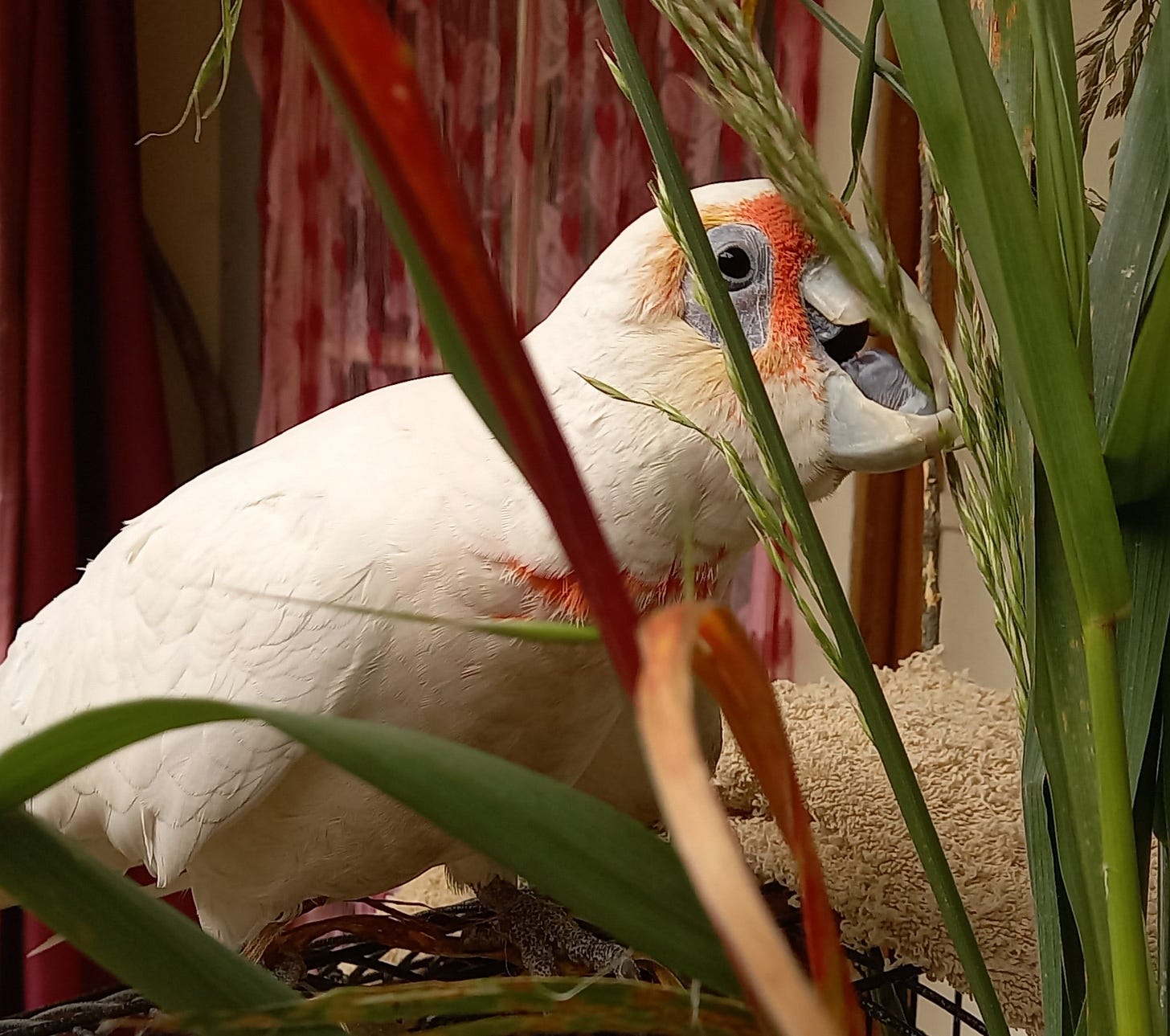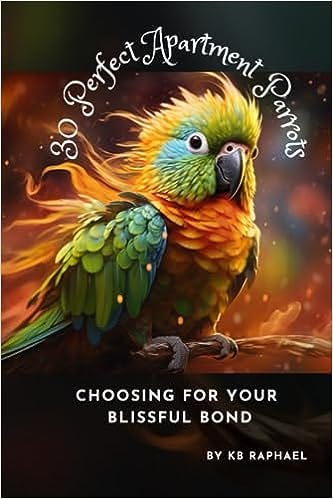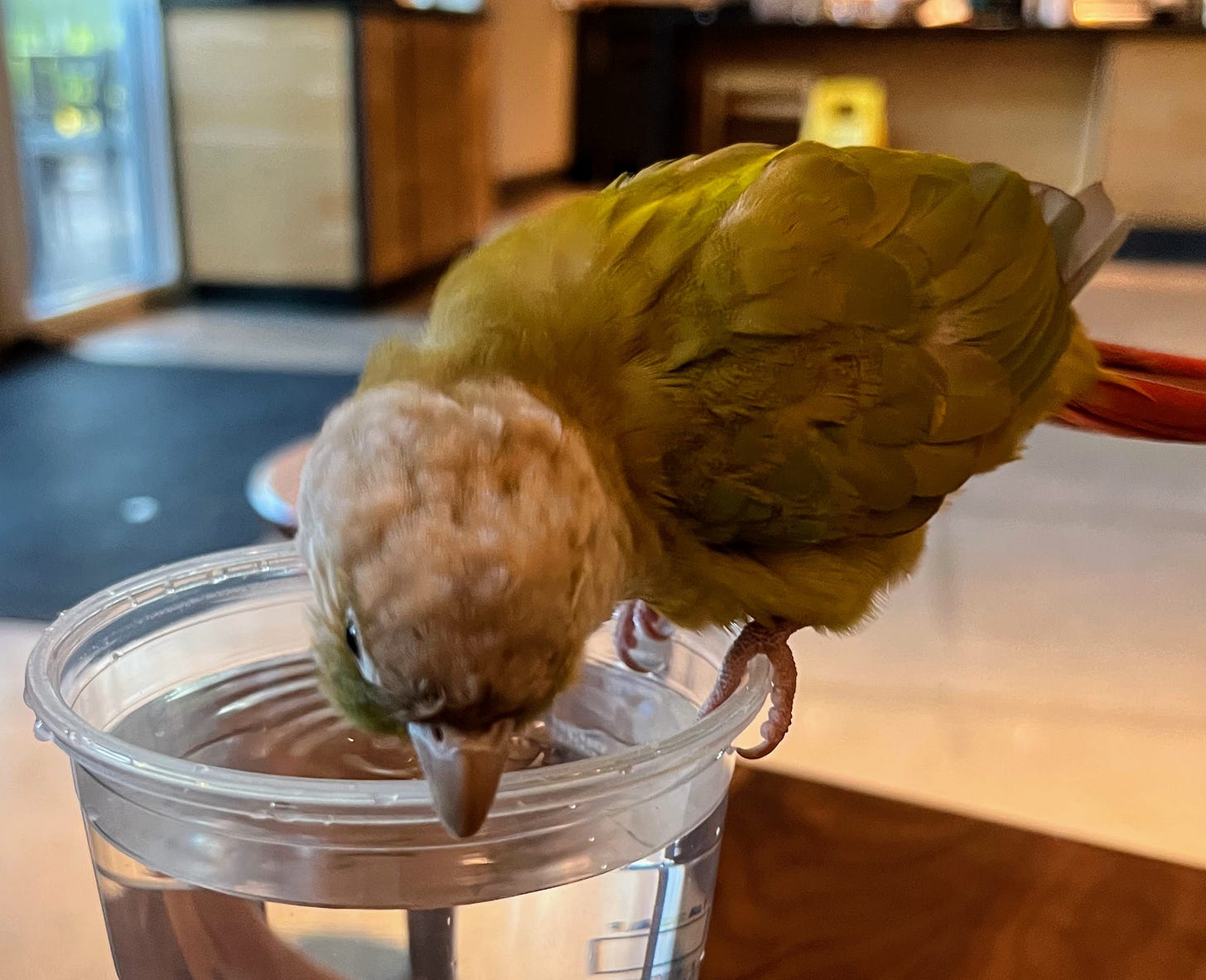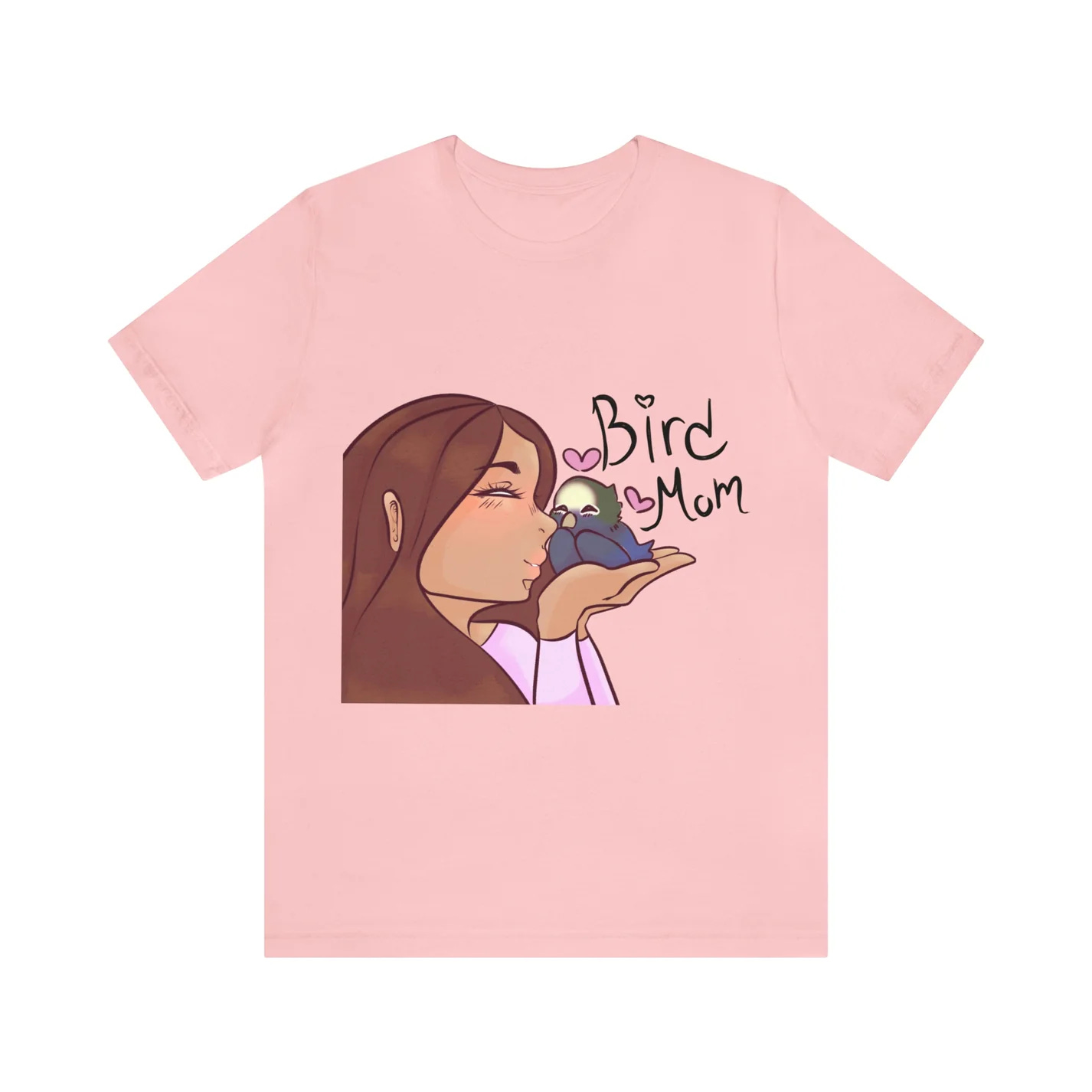Hello to our Cocka-tastic Gazette readers!
I am Aurabella, your feather-letter host! What crowning articles do I have for you today? Flying off the press:
Who Are The Australian Parrots?
Celebrating my new book: “30 Perfect Apartment Parrots”
Keep Your Parrot Healthy: Enemy #1!
Movie Time: What’s It Like Having A Parrot?
A shoutout to our YouTube members! You guys are the best feathered friends! ~
Enjoy! Squawkly yours, Aurabella
1. Who Are The Australian Grass Parrots?
Guest Writer: By Anser & Rax, his Slender-billed Corrella, in Australia
First things first: What do people mean when they talk about "Australian Grass Parrots"?
The thing about this term is that it can have many usages and meanings, depending who you're talking to and what you're talking about! It can refer to an individual species.... an entire genus of Australian parrots.... or even a whole bunch of distantly-related parrots with similar body-shapes and lifestyles. Much like the way the term 'parakeet' is used in the US to describe small, slender parrots with long tails. In Australia, "grass parrots" can mean different things, including:
1. At a species level, "grass parrots" is another common name for red-rumped parrots (psephotus haematonotus). In Australia, it's an 'intuitive' name for the little birds that hang out in small flocks in our parks, walking tracks, gardens and farms, that suddenly fly up from the ground right in front of you, but you had no idea were even there because their olivine and emerald camouflage in the green grass is so perfect. It's not until they spread their wings and you see the bright red rumps of the males that you even know what they are, or that they were there all along! They're like a little flock of magical, flying jewels!
2. As a genus of parrots, "grass parrots" typically refers to the Neophemas, which include; the scarlet-breasted, turquoise, orange-bellied, blue-winged, rock and elegant parrots. Sometimes, people will even chuck Bourke's parrots into this mix, despite them being in a different, but closely-related genus. Orange-bellied parrots are one of only two truly migratory parrots in the world (the other is the Swift Parrot-an Australian lorikeet) which migrate every year from their breeding grounds in Tasmania, across Bass Strait with it's Antarctic winds and turbulent currents, to the Australian mainland over Winter. They are also two of the rarest parrots in the world and are not generally available as pets or private aviary stock. Neophemas, as a genus, live across a wide range of environments, from temperate coastal forests of Tasmania, to the dry woodlands and grassy plains of the Eastern interior.
3. And finally; "Grass Parrots" can refer to any long-tailed Australian parrot that's not a cockatoo, but which feeds mostly on grass seeds and typically breeds after rain and near a water source. This can include all the aforementioned species, along with budgies, ground parrots, princess parrots, superb parrots and the (critically endangered) night parrots, along with several others.
So, what do all these parrots have in common?
No matter which environment they live in; whether it's arid, semi-arid, open woodland, temperate or coastal grasslands.... or a combination of these, grass parrots typically live on a seasonal diet of grass seeds (green and dry), thistle, ground-cover and shrub seeds. They breed after rain where there is plenty of access to green-seeding grasses, sprouting seeds and flowers, along with insect larvae, lerps and/or honeydew. Undernourished, unfit birds don't breed, acclimate or integrate as successfully as healthy, fit, engaged, well-nourished ones. Whether they're seasonal or nomadic breeders, it's the new growth after rain they rely upon to bring them into peak condition.
The reason green-seeding grasses with immature seeds are so important for the health of grass parrots is that green (immature) grass seeds are much higher in protein, micro-nutrients, calcium, alpha & beta carotenes and vitamins than mature, dry seeds, which tend to be much higher in carbohydrates, fats and soluble fiber needed to sustain a new plant that's not yet able to photosynthesize food for itself. Also, animal protein (as insects, lerps and honeydew) is more easily converted into muscle tissue, feathers, egg and bone than plant proteins, which helps explain why so many breeding parrots increase their animal protein intake when breeding and eating mostly green, immature seeds and sprouts.
What Australian Plants Can I Buy For Rotation Pots, Planted Aviary Or Garden?
Many nurseries around the world have ornamental Australian grasses and shrubs (or their relatives) available for sale, which can be grown in aviaries, pots, planters and gardens in many parts of the world. Some of the best for Australian Grass Parrots include:
1. Common Wallaby Grass – Danthonia tenuior
2. Wallaby Grass – Danthonia caespitosa
3. Weeping Grass also known as Meadow Rice Grass – Microlaena stipoides
4. Tussock Grass – Poa labillardieri.
5. Kangaroo Grass – Themeda australis
6. Coastal Spinifex** - Spinifex longifolius
7. Umbrella Sedge Plants**- Cyperus involucrucratus
These foods are also great for cockatiels, African lovebirds and other smaller parrots with natural, grass-based diets. They're also favourites with many finches and small doves and are great for rotating pots, garden-harvest or in a planted aviary. You may also have grasses native to your own area suitable for grass parrots to feed on too. As a general rule, if several species of wild finches, doves, grouse or fowl eat the seeds of local grasses, grass parrots can too. Just make sure it's clean, free of pollution (roadside grasses should be avoided) and free of diseases, moulds and animal droppings. You might even find you have some growing in your own backyard!
Grass parrots in captivity can be tricky to get to eat a balanced diet containing all the nutrients they need. Giving them foods that wild birds would instinctively access can be a source of stimulation and inquiry that engages birds in new activities; especially those used to a limited or dry-seed-only diet. The added nutritional benefits can do wonders for them. Give it a go and see! Your grass parrots will thank you for your effort!
2. What Apartment Parrot Is Perfect For You? 30 To Choose From!
Squawk!
Meet "30 Perfect Apartment Parrots," where my avian wisdom shines. With 30 diverse species grouped into four categories – Golden, Silver, Bronze, and Conure, find your ideal apartment parrot effortlessly. Perfect for nest seekers and those looking for easy-to-live-with birds: 🦜💕 Talker, smaller, medium sized? What’s perfect for you?
Order at 30 Perfect Apartment Parrots
3. Keep Your Parrot Healthy
Birdie Enemy #1 is Clear!
When it comes to our pet parrots and keeping them healthy and safe, I find that most people will do whatever it takes. They buy expensive specialty teas, food or bottled water. They spend money buying toys for their birds or time making toys; and they get UVB lights for their cages, which they keep clean.
Good husbandry is paramount and it makes a difference!
Still, do you know what the #1 cause of infection is in birds?
A lack of clean water!
One of the most important things you can do for your pet parrot is to make sure that they have clean drinking water.
Yes, fresh water is important. Depending on how your city handles the water, it may or may not be drinkable for your parrot. Tap water can hold bacteria and you and I can handle, but that doesn’t necessarily mean that your parrot can.
To provide your parrot with fresh drinking water, you can buy bottled water, treat the water correctly with bleach (which includes using the appropriate amount and then allowing the bleach enough time to evaporate), use and upkeep a water-filtering system or you can boil the water and allow it to cool to room temperature before serving.
What To Look Out For
1 Wash the water dish:
Although a water dish doesn’t get dirty the way a food dish does, even if your parrot doesn’t stick pellets or food into the dish, it does collect bacteria in time. For this reason, wiping the dish clean with a sponge and soapy water or running the dish through the dishwasher is best. Yes, the water must be clean, but your dish must be too.
2 Water filtration systems:
My avian veterinarian has told me that one of the biggest problems with providing clean water some parrot owners encounter is that they don’t always know when their water filter has stopped working. Once a filter needs to be replaced, it can begin to collect bacteria instead of cleaning the water of bacteria. If you use a water filter for your parrots, be sure to have a regular filter-cleaning or replacing schedule so that the clean water you think you are providing truly is clean!
3 Water Bottles
When it comes to water bottles or fancy piped water systems for parrots, these can go a long ways towards protecting the water, keeping pellets from being dunked into the water or keeping any other debris out. However, these systems can be hard to monitor because their spigot or water-access points can be harder to clean or to ensure that it is functioning. Make sure to wash the mouthpiece as best you can so that a the ball in the tip is clean or that the system is proper flushed for cleaning regularly.
Of course, a proper diet is key to a parrot’s health, but clean water trumps the diet. Even bathing water should be clean, like their drinking water, to ensure the best health for your feathered companion!
4. Movie Time!
Popcorn and the biggest question!
If you have parrots, you know. Otherwise, if you’re looking at getting a parrot, what will it be like to HAVE a parrot? 🍿🦜
Here’s my take, LMK what you think! What’s It Like Having Parrots?
Spread the wings! If you enjoy the newsletter, please squak about it to your friends and share! 🐦✨
Not subscribed? – subscribe now for a wing-derful experience! 🐦🌟
Got a chatty youngster to entertain? How about diving into a parrot-themed coloring book designed for both kids and adults? 🎨🦜
Need to cover your featherless self? Birb-tee?
Fall-tastic goodbyes for now, see you soon, 🦜👋
Lorenza
I’ll see you next time! Aurabella, Umbrella Cockatoo








